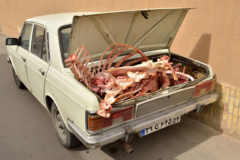Paykan. I read about the brand in Girls, Muslims and Motors for the first time. That is about the journey. And, surprisingly perhaps for two motorcyclists, also something about cars if that is used in speech.
The Paykan was a car made by Iranian vehicle manufacturer Iran Khodro. The word Paykan is Persian for arrow. And the logo is that of a classic chariot. The car was built from 1967 to 2005 and was particularly popular in Iran. The car cost approximately € 5000 and a lifetime of 20 years turned out to be not exceptional. There is of course hardly any pickling in Iran ...
The beginning
After unsuccessful attempts to build FIATs in Iran under license, brothers Ali Akbar and Mahmoud Khayami founded the company Iran National Factories in 1962. They get a license to produce the British Hillman Hunter, which they got released. By 1966, the story was so complete that the company was allowed to build several four-cylinder models. In 1967 the assembly line was finished and production started with –m – 6000 units per year. The cars were made by Hillman and sent as Complete Knocked Down kits (all in parts) to Iran, where they were assembled. That's how a lot of Hillman Hunters got a new homeland like Paykan ..
Adopted by Peugeot
At the end of the 1960 years, the Rootes Group, of which Hillman was a part, was taken over by Chrysler. At the end of the 1970 years the group was sold on to the French Peugeot. They actually wanted to start a successor for the Paykan, but the Iranian Revolution of 1979 prevented that. The required foreign capital was inaccessible after the revolution. That is why Iran Khodro decided, as the company was now called, to keep the outdated Paykan in production. In 1985 an agreement was reached with Peugeot whereby Peugeot would supply 60.000 engines and wheel suspension systems for the Paykans every year for six years.
The New Paykan
From 1991 onwards Iran Khodro tried to produce parts in-house. In 1993, the company transferred these activities to the separate division. The machines for this had been purchased from Talbot that by that time they really no longer needed them. Iran Khodro also set up its own research department in 1994. He became responsible for the style and technology of the products. The development of the New Paykan was now scheduled.
The end
In 1990 Iran Khodro had started producing the Peugeot 405 and later other Peugeot models followed, including the Peugeot 206 in 2001. After 2,3 million copies, the last Paykan was produced on 15 in May 2005. The New Paykan has since evolved into the new Samand, which succeeded the Paykan. Shortly thereafter, the entire Paykan assembly line was sold to Kenya. After the end of production, Iran Khodro will continue to provide spare parts for 10 for a year. It is expected that the Paykan, which still accounts for one third of the Iranian fleet in 2007, will one day disappear from the Iranian street scene. However, the average lifespan of Paykans is around twenty years. So it may take a while.









For years I have felt lonely as one of the few enthusiasts and owner of these undervalued cars.
Now suddenly so much contact with former residents from Iran who are looking for an 'Arrow'.
Nice development!
Theo D Haverkamp
The most brilliant is the intermediate form Peugeot ROA. Paykan chassis, Peugeot 405 bodywork, or a Peugeot 405 with leaf springs and rear-wheel drive.
I totally agree with you!
The “Arrows” were the last models of the Rootes Group developed without the influence of Chrysler and proved themselves with the 1725cc as rock-solid cars without significant problems or pretensions. Certainly not an exciting design but British buyers had other priorities given the misery that ran off the line at British Leyland and Rootes (Imp / Avenger). And afterwards they are quite cute with their “Lada-like” look and the Humber Scepter is even stylish.